
Huerniopsis decipiens Photo by: Julio C. García
Origin and Habitat: Botswana, Namibia, Republic of South Africa (Northern Cape)
Habitat and ecology: Huerniopsis decipiensSN|29664]]SN|29664]] is a subcanopy species that occurs in the Acacia woodland on shallow stony soils. Other Stapeliae (Asclepiadaceae), namely Orbeopsis knobelii and Pachycymbium lugardii are largely confined to the region.
Synonyms:
See all synonyms of Huerniopsis decipiens
back
Accepted name in llifle Database:Huerniopsis decipiens N.E.Br.J. Linn. Soc., Bot. 17: 171 (1878)Synonymy: 4
back
Common Names include:
CHINESE (中文): 类剑龙角属
Description: Huerniopsis decipiensSN|29664]]SN|29664]], best known in cultivation as Piaranthus decipiensSN|29665]]SN|29665]], is a distinct stapeliad characterized by flowers of elaborate design and beauty that came in a wide variety of colours, either uniform shades of reddish, brown, maroon, or faintly green with white or with a varying amount of yellowish mottling. Under cultivation the flowers emit their very sweetish-nauseous odour most strongly during the evening, the next morning it has almost disappeared, so this plant is probably fertilised by a late-flying insect. The corona-lobes secrete a sweet fluid copiously upon their backs and sides. Flowers opens simultaneously or with long intervals in late Summer or Autumn.
Stems: Decumbent, more or less clavate, 2-7.5 cm long, 8-13 mm thick, obtusely 4-angled, with spreading teeth 2-3 mm long, glabrous, dull green or purplish tinted; teeth with a minute tooth on each side at the base of the ultimately marcescent tips.
Flowers: 2–4 together at the middle or towards the top of the young stems, opening successively. Pedicels 2-6 mm long, 2 mm in diameter, stout, glabrous. Sepals 5-8 mm long, lanceolate, subulate, acuminate, glabrous. Corolla in bud glabrous, ellipsoid, acuminate, 5-angled, when expanded about 20-25 mm in diameter, glabrous outside and within, fringed at the base of the lobes with a few vibratile clavate dark purple hairs1 - 2.5 mm long, outside pale green-grey, often patterned with purplish-grey, inside brownish-red or rich brownish-crimson, more or less mottled with yellow, the intensity of colour varying even in flowers of the same cluster. Tube 8-10 mm long, and as much in diameter, shallow to deeply campanulate. Lobes 8-12 mm long, 6-8 mm broad at the base, deltoid-ovate, acuminate or very acute, basally depressed, almost erect, then increasingly recurved, inside velvety. Coron cream to pale brown, sometimes spotted with red-brown, conical, fleshy. Corona-lobes about 5 mm long, very stout, nearly square in transverse section at the lower adnate part, with subulate acute connivent-erect tips much exceeding the anthers, purplish on the back and at the apex, yellowish on the slightly concave sides below the middle.
Fruits: 12-18 cm long, 0.5-0.6 cm broad.
Seeds: About 6 x 4 mm, pale brown.
Taxonomy note: The genus Huerniopsisis distinguished from its near allies Huernia and Piaranthus; from the former by the absence of an outer corona and absence of teeth between the corolla-lobes, and from the latter by its tubular corolla and absence of a dorsal crest.
Bibliography: Major references and further lectures
1) Doreen Court “Succulent Flora of Southern Africa” CRC Press, 01/Jun/2000
2) Focke Albers, Ulrich Meve “Illustrated Handbook of Succulent Plants: Asclepiadaceae: Asclepiadaceae” Volume 4 Springer Science & Business Media, 2002
3) Edgar Lamb “Stapeliads in Cultivation” Blandford Press, 1957
4) N. E. Brown “Flora Capensis”, Vol 4, page 518 1909
5) Werner Rauh “The Wonderful World of Succulents: Cultivation and Description of Selected Succulent Plants Other Than Cacti” Smithsonian Institution Press, 1984
6) Foden, W. & Potter, L. 2005. Piaranthus decipiens (N.E.Br.) Bruyns. National Assessment: Red List of South African Plants version 2014.1. Accessed on 2014/11/25
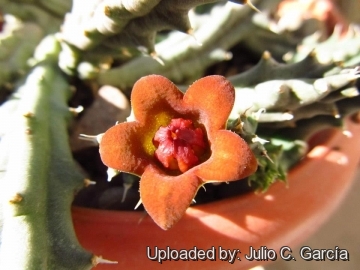 Huerniopsis decipiens Photo by: Julio C. García
Huerniopsis decipiens Photo by: Julio C. García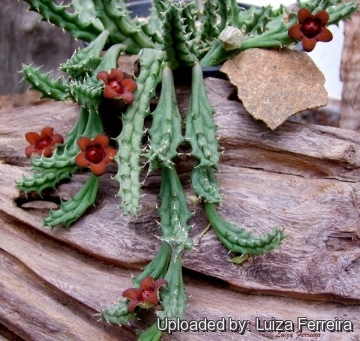 Huerniopsis decipiens Photo by: Luiza Ferreira
Huerniopsis decipiens Photo by: Luiza Ferreira A rare mottled flower. Photo by: Luiza Ferreira
A rare mottled flower. Photo by: Luiza Ferreira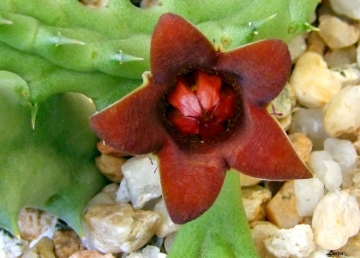 Huerniopsis decipiens Photo by: Luiza Ferreira
Huerniopsis decipiens Photo by: Luiza Ferreira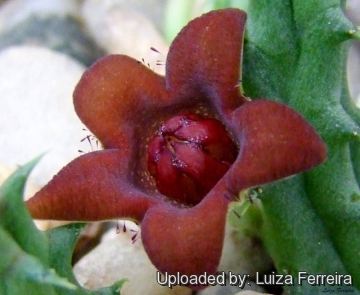 Huerniopsis decipiens Photo by: Luiza Ferreira
Huerniopsis decipiens Photo by: Luiza Ferreira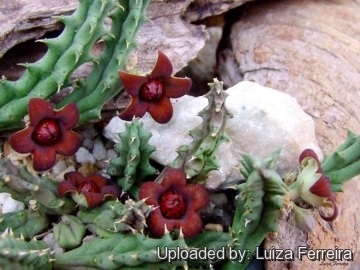 Huerniopsis decipiens Photo by: Luiza Ferreira
Huerniopsis decipiens Photo by: Luiza FerreiraCultivation and Propagation: Huerniopsis decipiensSN|29664]]SN|29664]] is an easy obliging blooming plant, which is happy in any average succulent house. This plant is common to warrant any description, let it suffice to say that this plant is easy to grow and flower, and one which will tolerate most soils and growing conditions.
Soil: Since roots are quite shallow, use a cactus mix or add extra perlite or pumice to regular soil potting soil. A gritty, very free-draining compost is suitable, and clay pots help the plants to dry out between watering.
Watering: They require moderately watering through the growing season but enjoy plenty of water and some fertiliser in hot weather, this helps them to flower freely. Water more sparingly in winter according to temperatures. But, as with most asclepiads, it is unwise to leave them wet in cold weather.
Hardiness: Winter care presents no problems at 5°C with plenty of light.
Sun Exposure: Partial sun or light shade.
Pest and diseases: They are generally fairly easy to grow, especially if kept pest-free. They are susceptible to stem and root mealy bugs, and damage from these may well initiate fungal attack. If you do have problems with a stem or with basal rotting, you can reliably isolate the healthy parts, dry them off, and re-root them in moist compost.
Cultural Practices: Re-pot every 2 years.
Propagation: Easiest with stem cuttings. Allow cuttings to dry a day before planting. Stems must be laid (Not buried) on gritty compost and will then root from the underside of the stems. It can also be increased from seeds sowing in spring in moist, sandy peat moss. Barely cover seeds.
















